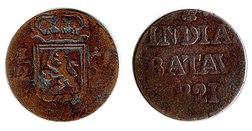
Back Florí de les Índies Orientals Neerlandeses Catalan Florín de las Indias Orientales Neerlandesas Spanish Florin des Indes orientales néerlandaises French Gulden Hindia Belanda ID Fiorini delle Indie orientali olandesi Italian Gulden Hindia Belanda Malay Nederlands-Indische gulden Dutch Gulden Holenderskich Indii Polish Florim das Índias Orientais Neerlandesas Portuguese Гульден Нидерландской Индии Russian
This article includes a list of references, related reading, or external links, but its sources remain unclear because it lacks inline citations. (April 2009) |
fl. | |
|---|---|
 1821 Indiae Batav 1⁄2 stuiver | |
| Unit | |
| Unit | guilder |
| Plural | guilders |
| Symbol | ƒ |
| Denominations | |
| Subunit | |
| 1⁄100 | cent |
| Plural | |
| cent | cents |
| Symbol | |
| cent | c |
| Banknotes | |
| Freq. used | ƒ1⁄2 , ƒ1 , ƒ2+1⁄2 , ƒ5, ƒ10, ƒ25, ƒ50, ƒ100 |
| Coins | |
| Freq. used | 1⁄2c, 1c, 2+1⁄2c, 1⁄10ƒ, 1⁄4ƒ |
| Demographics | |
| Date of introduction | 1602 |
| Replaced by |
|
| User(s) | Netherlands Indies |
| Issuance | |
| Central bank | Dutch government De Javasche Bank |
| This infobox shows the latest status before this currency was rendered obsolete. | |
The Netherlands Indies guilder (Dutch: Nederlands-Indische gulden, Malay-Van Ophuijsen spelling: Roepiah Hindia-Belanda[1]) was the unit of account of the Dutch East Indies from 1602 under the United East India Company (Dutch: Vereenigde Oost-Indische Compagnie; VOC), following Dutch practice first adopted in the 15th century (guilder coins were not minted in the Netherlands between 1558 and 1681 and none circulated in the Indies until a century later). A variety of Dutch, Spanish and Asian coins were in official and common usage. After the collapse of the VOC at the end of the 18th century, control of the islands reverted to the Dutch government, which issued silver 'Netherlands Indies' guilder and fractional silver and copper coins until Indonesian independence in 1945.
- ^ "Pers-Communique Tentang Peroebahan Verordening Rechtsverkeer in Oorlogstijd". Keng Hwa Poo (in Indonesian). Vol. 48. Menado: S. H. Liem (Handelsd kkerij Liem Oei Tiong & Co). 31 May 1941. p. 4.
© MMXXIII Rich X Search. We shall prevail. All rights reserved. Rich X Search